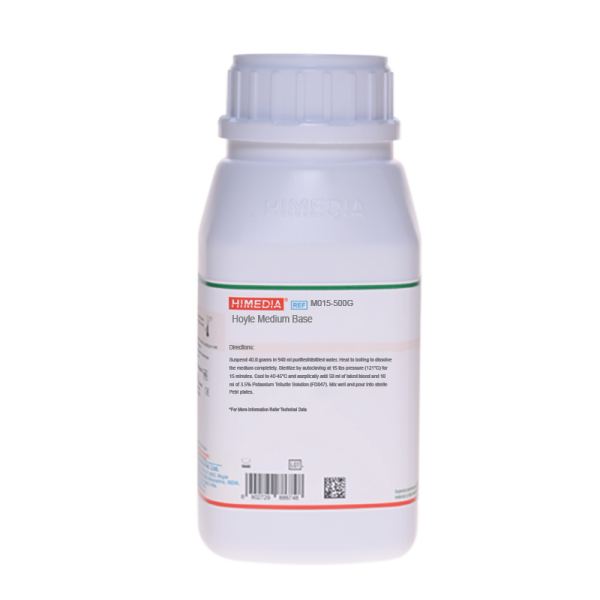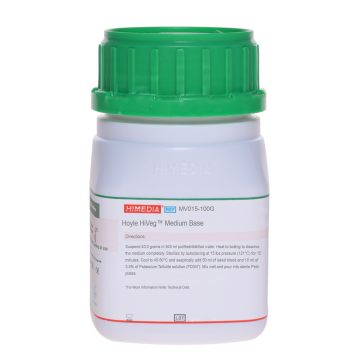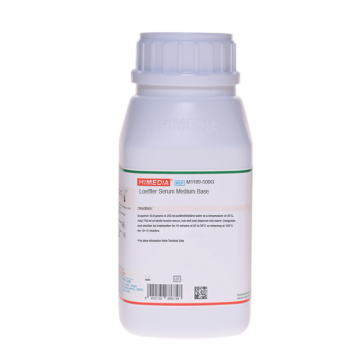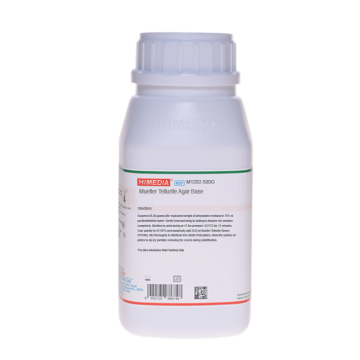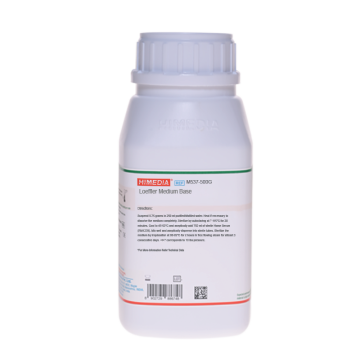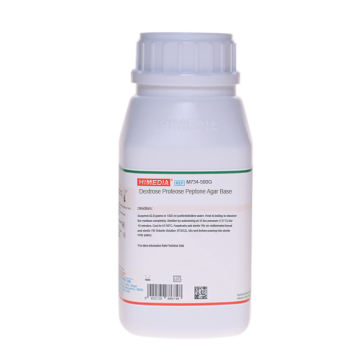 Your enquiry has been submitted
Your enquiry has been submitted
Hoyle Medium Base
Intended use
A highly selective medium used for the isolation and differentiation of Corynebacterium diphtheriae types from clinical and non-clinical specimens.
Composition**
| Ingredients | g/L |
|---|---|
| Peptone | 10.000 |
| HM peptone B# | 10.000 |
| Sodium chloride | 5.000 |
| Agar | 15.000 |
Final pH (at 25°C): 7.8±0.2
**Formula adjusted, standardized to suit performance parameters
# - Equivalent to Beef extract
Directions
Suspend 40.0 grams in 940 ml purified / distilled water. Heat to boiling to dissolve the medium completely. Sterilize by autoclaving at 15 lbs pressure (121°C) for 15 minutes. Cool to 45-50°C and aseptically add 50 ml of laked blood and 10 ml of PTe 3.5% Selective Supplement (1 ml per vial) (FD047). Mix well and pour into sterile Petri plates.
Principle And Interpretation
The most common disease caused by Corynebacterium diphtheriae is diphtheria, an acute communicable disease manifested by both local infection of the upper respiratory tract and the systemic effects of the toxin, which are most notable in the heart and peripheral nerves (1). Hoyle Medium Base, formulated by Hoyle (2), is the modification of the original formulation of Neill, for the isolation and differentiation of C. diphtheriae. This medium is not inhibitory to some mitis types of Corynebacterium, as the original formulation.
Peptone and HM peptone B supply carbon, nitrogen substances, amino acids, vitamins and other essential growth nutrients. Potassium tellurite is a selective agent, which inhibits most of the normal flora of the upper respiratory tract except Corynebacterium. Hoyle's Medium is a highly selective medium and should be used in conjunction with a non-selective media such as Loeffler Serum Medium (M537) and Blood Agar Base (M089) with 10% horse blood (3). C.diphtheriae are usually present in small numbers permitting the formation of well isolated colonies. So, inoculation is done by directly rubbing the swab over the entire surface of the medium. Incubation should be carried out till 72 hours if the results are negative. To study the morphology, gentian violet staining is done. To demonstrate the characteristic morphology and staining reactions of C.diphtheriae by Neissers or Alberts method, it is advisable to use colonies from Loeffler Medium. The toxigenicity of C.diphtheriae strains can be determined by Eleks (4) method.
Type of specimen
Clinical samples - Throat swab, nasal swab, wound swab
Specimen Collection and Handling:
For clinical samples follow appropriate techniques for handling specimens as per established guidelines (3,5).
After use, contaminated materials must be sterilized by autoclaving before discarding.
Warning and Precautions :
In Vitro diagnostic Use only. For professional use only. Read the label before opening the container. Wear protective gloves/protective clothing/eye protection/ face protection. Follow good microbiological lab practices while handling specimens and culture. Standard precautions as per established guidelines should be followed while handling clinical specimens. Safety guidelines may be referred in individual safety data sheets.
Limitations :
- 1.Each lot of the medium has been tested for the standard organisms specified on the COA. However, hospital isolates may show variable growth depending on nutritional requirement.
- 2.Biochemical and serological tests must be carried out for confirmation.
Performance and Evaluation
Performance of the medium is expected when used as per the direction on the label within the expiry period when stored at recommended temperature.
Quality Control
Appearance: Cream to yellow homogeneous free flowing powder
Gelling: Firm, comparable with 1.5% Agar gel
Colour and Clarity of prepared medium: Basal Medium: Amber coloured, clear to slightly opalescent gel After Addition of blood & Tellurite : Brownish red coloured opaque gel forms in Petri plates
Reaction: Reaction of 4.0% w/v aqueous solution at 25°C. pH : 7.8±0.2
pH: 7.60-8.00
Cultural Response
Cultural characteristics observed with added 50 ml of laked blood and tellurite solution after an incubation at 35-37°C for 18-24 hours.
| Organism | Inoculum (CFU) | Growth | Recovery | Colony characteristics |
|---|---|---|---|---|
| ** Bacillus spizizenii ATCC 6633 (00003*) | >=104 | inhibited | 0% | |
| C. diphtheriae type intermedius 14779 | 50-100 | good-luxuriant | >=50% | grey colonies with darker centers |
| Corynebacterium diphtheriae type mitis | 50-100 | good-luxuriant | >=50% | grey colonies with shining surface |
| Escherichia coli ATCC 25922 (00013*) | >=104 | inhibited | 0% | |
| Enterococcus faecalis ATCC 29212 (00087*) | 50-100 | good-luxuriant | >=50% | black minute colonies |
Key: (*) Corresponding WDCM numbers.
**Formerly known as Bacillus subtilis subsp. spizizenii
Storage and Shelf Life
Store between 10-30°C in a tightly closed container and the prepared medium at 2-8°C. Use before expiry date on the label. On opening, product should be properly stored dry, after tightly capping the bottle in order to prevent lump formation due to the hygroscopic nature of the product. Improper storage of the product may lead to lump formation. Store in dry ventilated area protected from extremes of temperature and sources of ignition Seal the container tightly after use. Product performance is best if used within stated expiry period.
Disposal
User must ensure safe disposal by autoclaving and/or incineration of used or unusable preparations of this product. Follow established laboratory procedures in disposing of infectious materials and material that comes into contact with clinical sample must be decontaminated and disposed of in accordance with current laboratory techniques (3,5).
Reference
- Murray P. R., Baron J. H., Pfaller M. A., Jorgensen J. H. and Yolken R. H., 8th Ed., American Society for Microbiology, Washington, D.C. (Ed.), 2003, Manual of Clinical Microbiology.
- Hoyle I., 1941, Lancet., 1:175.
- Isenberg, H.D. Clinical Microbiology Procedures Handbook 2nd Edition.
- Elek S. D., 1948, Brit. Med. A1:493.Isenberg, H.D. Clinical Microbiology Procedures Handbook 2nd Edition.
| Product Name | Hoyle Medium Base |
|---|---|
| SKU | M015 |
| Product Type | Regular |
| Physical Form | Powder |
| Origin | Animal |
| Packaging type | HDPE |
| References | 1.Murray P. R., Baron J. H., Pfaller M. A., Jorgensen J. H. and Yolken R. H.,8th Ed., American Society for Microbiology, Washington, D.C. (Ed.), 2003, Manual of Clinical Microbiology,2.Hoyle I., 1941, Lancet., 1:175. 3.MacFaddin J. F., 1985, Media for Isolation-Cultivation-Identification-Maintenance of Medical Bacteria, Vol. 1, Williamsand Wilkins, Baltimore. 4.Elek S. D., 1948, Brit. Med. A1:493. 5.Isenberg, H.D. Clinical Microbiology Procedures Handb0ook. 2nd Edition. 6.Jorgensen,J.H., Pfaller , M.A., Carroll, K.C., Funke, G., Landry, M.L., Richter, S.S and Warnock., D.W. (2015)Manual of Clinical Microbiology, 11th Edition. Vol. 1. |
| Customized Product Available | No |



